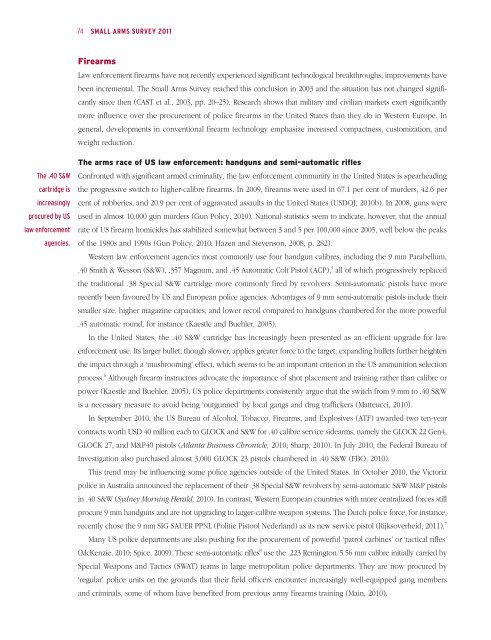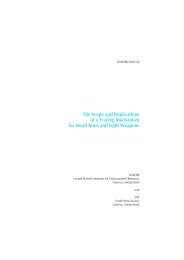A TASER International representative displays a prototype for the ...
A TASER International representative displays a prototype for the ...
A TASER International representative displays a prototype for the ...
You also want an ePaper? Increase the reach of your titles
YUMPU automatically turns print PDFs into web optimized ePapers that Google loves.
74 SMALL ARMS SURVEY 2011<br />
Firearms<br />
Law en<strong>for</strong>cement firearms have not recently experienced significant technological breakthroughs; improvements have<br />
been incremental. The Small Arms Survey reached this conclusion in 2003 and <strong>the</strong> situation has not changed significantly<br />
since <strong>the</strong>n (CAST et al., 2003, pp. 20–25). Research shows that military and civilian markets exert significantly<br />
more influence over <strong>the</strong> procurement of police firearms in <strong>the</strong> United States than <strong>the</strong>y do in Western Europe. In<br />
general, developments in conventional firearm technology emphasize increased compactness, customization, and<br />
weight reduction.<br />
The .40 S&W<br />
cartridge is<br />
increasingly<br />
procured by US<br />
law en<strong>for</strong>cement<br />
agencies.<br />
The arms race of US law en<strong>for</strong>cement: handguns and semi-automatic rifles<br />
Confronted with significant armed criminality, <strong>the</strong> law en<strong>for</strong>cement community in <strong>the</strong> United States is spearheading<br />
<strong>the</strong> progressive switch to higher-calibre firearms. In 2009, firearms were used in 67.1 per cent of murders, 42.6 per<br />
cent of robberies, and 20.9 per cent of aggravated assaults in <strong>the</strong> United States (USDOJ, 2010b). In 2008, guns were<br />
used in almost 10,000 gun murders (Gun Policy, 2010). National statistics seem to indicate, however, that <strong>the</strong> annual<br />
rate of US firearm homicides has stabilized somewhat between 3 and 5 per 100,000 since 2005, well below <strong>the</strong> peaks<br />
of <strong>the</strong> 1980s and 1990s (Gun Policy, 2010; Hazen and Stevenson, 2008, p. 282).<br />
Western law en<strong>for</strong>cement agencies most commonly use four handgun calibres, including <strong>the</strong> 9 mm Parabellum,<br />
.40 Smith & Wesson (S&W), .357 Magnum, and .45 Automatic Colt Pistol (ACP), 5 all of which progressively replaced<br />
<strong>the</strong> traditional .38 Special S&W cartridge more commonly fired by revolvers. Semi-automatic pistols have more<br />
recently been favoured by US and European police agencies. Advantages of 9 mm semi-automatic pistols include <strong>the</strong>ir<br />
smaller size, higher magazine capacities, and lower recoil compared to handguns chambered <strong>for</strong> <strong>the</strong> more powerful<br />
.45 automatic round, <strong>for</strong> instance (Kaestle and Buehler, 2005).<br />
In <strong>the</strong> United States, <strong>the</strong> .40 S&W cartridge has increasingly been presented as an efficient upgrade <strong>for</strong> law<br />
en<strong>for</strong>cement use. Its larger bullet, though slower, applies greater <strong>for</strong>ce to <strong>the</strong> target; expanding bullets fur<strong>the</strong>r heighten<br />
<strong>the</strong> impact through a ‘mushrooming’ effect, which seems to be an important criterion in <strong>the</strong> US ammunition selection<br />
process. 6 Although firearm instructors advocate <strong>the</strong> importance of shot placement and training ra<strong>the</strong>r than calibre or<br />
power (Kaestle and Buehler, 2005), US police departments consistently argue that <strong>the</strong> switch from 9 mm to .40 S&W<br />
is a necessary measure to avoid being ‘outgunned’ by local gangs and drug traffickers (Matteucci, 2010).<br />
In September 2010, <strong>the</strong> US Bureau of Alcohol, Tobacco, Firearms, and Explosives (ATF) awarded two ten-year<br />
contracts worth USD 40 million each to GLOCK and S&W <strong>for</strong> .40 calibre service sidearms, namely <strong>the</strong> GLOCK 22 Gen4,<br />
GLOCK 27, and M&P40 pistols (Atlanta Business Chronicle, 2010; Sharp, 2010). In July 2010, <strong>the</strong> Federal Bureau of<br />
Investigation also purchased almost 3,000 GLOCK 23 pistols chambered in .40 S&W (FBO, 2010).<br />
This trend may be influencing some police agencies outside of <strong>the</strong> United States. In October 2010, <strong>the</strong> Victoria<br />
police in Australia announced <strong>the</strong> replacement of <strong>the</strong>ir .38 Special S&W revolvers by semi-automatic S&W M&P pistols<br />
in .40 S&W (Sydney Morning Herald, 2010). In contrast, Western European countries with more centralized <strong>for</strong>ces still<br />
procure 9 mm handguns and are not upgrading to larger-calibre weapon systems. The Dutch police <strong>for</strong>ce, <strong>for</strong> instance,<br />
recently chose <strong>the</strong> 9 mm SIG SAUER PPNL (Politie Pistool Nederland) as its new service pistol (Rijksoverheid, 2011). 7<br />
Many US police departments are also pushing <strong>for</strong> <strong>the</strong> procurement of powerful ‘patrol carbines’ or ‘tactical rifles’<br />
(McKenzie, 2010; Spice, 2009). These semi-automatic rifles 8 use <strong>the</strong> .223 Remington/5.56 mm calibre initially carried by<br />
Special Weapons and Tactics (SWAT) teams in large metropolitan police departments. They are now procured by<br />
‘regular’ police units on <strong>the</strong> grounds that <strong>the</strong>ir field officers encounter increasingly well-equipped gang members<br />
and criminals, some of whom have benefited from previous army firearms training (Main, 2010).

















